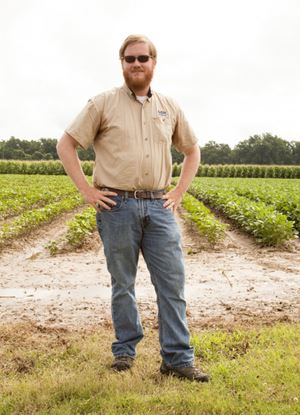The Right Variety
Study Helps Midsouth Soybean Growers Select Optimum Varieties
ST. JOSEPH, LA.
A collaborative project with six other states across the Midsouth is helping farmers select soybean varieties best suited to their environment, according to Dr. Josh Lofton, research agronomist at the Macon Ridge Research Station for the LSU AgCenter.

A project helping farmers select soybean varieties best suited for their environment was discussed by Dr. Josh Lofton, research agronomist at the Macon Ridge Research Station for the LSU AgCenter
Photo by John LaRose, Jr.
The project includes the Midsouth area ranging from the Bootheel of Missouri all the way down to southern Texas, and from Texas all the way to eastern Mississippi. Six different Universities participating in the study are using the same layout, the same details and are studying different maturity groups to see how they’re affected by the planting date.
“We all know that variety selection is important and critical especially for soybeans,” Lofton said. “Our growers need to compare varieties, and we see that our maturity groups are a great tool in the process. This is because these maturity groups function differently in certain parts of the state. Additionally, in Louisiana we have maturity groups that fit the state better compared to other states. Furthermore, Optimum maturity groups selection can be influenced by many management decisions, one of these being planting date.”
In Louisiana there is a very wide window for planting soybeans. Planting dates range from the later part of March all the way through early May. There’s also that unique double-crop situation where soybeans are planted in late May or early June after winter wheat harvest.
“When we talk about optimum planting dates, we have to think about our late season insect pressure and all those late season risk factors we have with soybeans,” he continued. “Those are also influenced by our maturity groups selection and our critical planting date.
“In this study, we’re evaluating four maturity groups, four different planting dates, taking a lot of phenological measurements, looking at when the soybean plant actually goes from vegetative to reproductive, when pod fill begins, when we get to physiological and harvest maturity, as well as our harvest data. Then once we have that harvest data we’re actually looking at that soybean seed quality as well and looking at accelerated aging, germination, all those critical factors we think of as more of an interim process.”
The study has shown overall that maturity Groups IV and V are superior maturity groups for selection in Louisiana. Group V yielded higher at early planting dates. From early April through the end of April, maturity Group V performed better than all other maturity groups studied. However, in that double-crop situation in late May and June, the Group IVs actually come in close competition with Group Vs and in that late season, Group IV actually surpassed Group V, becoming the better variety selection.
“Overall those maturity Groups IIIs and VIs did not perform as well, however there are some niches where Group VIs did reasonably well in early season, and maturity Group IIIs did reasonably well in the late season, however not as well as those maturity Group IVs and Vs.”
Considering harvest ability and damaged seed, maturity Groups IVs and Vs were better, had less damaged seed, and better harvest ability.
“We also learned the reason why those Group Vs started to decline in late season; it is because harvest ability started to decline,” Lofton noted. “We had taller plants, not as many nodes though, or just the same as the Group IVs, so we had more vine like plants and they did not go through the combine as well.
So, overall growers in Louisiana should continue to think of Group IVs and Vs as the maturity groups to select.
“According to this study, if you plant early, those Group Vs are what you need, however when you go to later planting dates, especially if you’re in a double-crop situation, you can start focusing on those Group IVs as far as your overall optimum variety for those individual production systems,” Lofton summed.∆
BETTY VALLE GEGG-NAEGER: Senior Staff Writer, MidAmerica Farmer Grower |
|
|
|